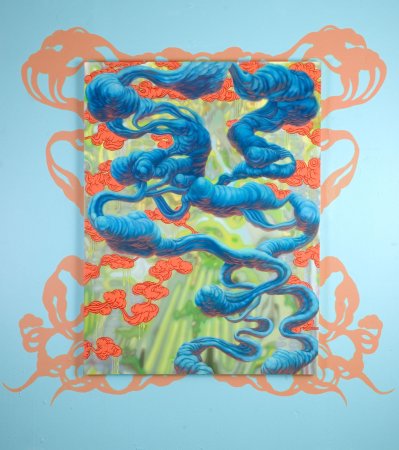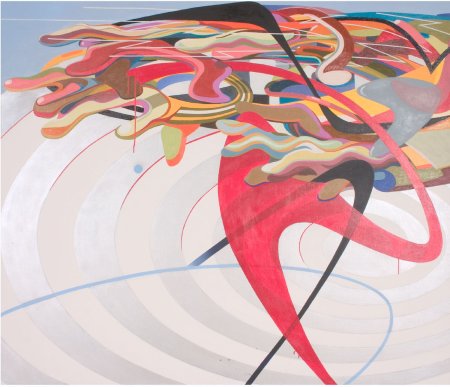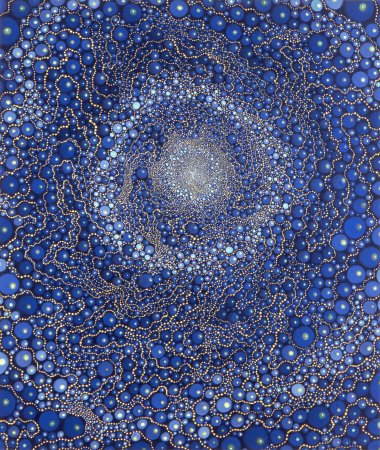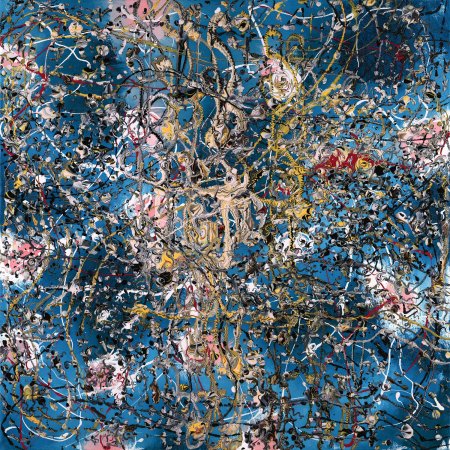Previous: Boston's first Dr. Sketchy's Anti-Art School Burlesque Life Drawing Class (11)
Big Bang! at the DeCordova
Post #964 • March 1, 2007, 6:53 PM • 5 Comments
Lincoln, MA—For several weeks I have been putting off writing a review of Big Bang! Abstract Painting for the 21st Century, up through April 22 at the DeCordova, and last night it finally occurred to me why. This is a thoughtful, broad attempt to exhibit abstract painters in the region, diverse in their approaches, and treated with respect befitting a viable, lively, and active tradition. Without making too much of it, the exhibition regards abstract painting as a contemporary activity. With a couple of minor edge cases, it consists entirely of painting, without spurious redefinitions of painting
intended to include other media. As such, this is the kind of exhibition that I waited in vain for over a decade for a Miami museum to mount, as a sign that somebody was thinking with any seriousness about the dedicated local painters whose priorities were primarily visual and aesthetic, the poor sods. On some level, I was reluctant to revisit those feelings of frustration that helped drive me out of town. But the good news is that it turns out, contrary to what one might gather from prolonged life in the provinces, that the entire contemporary art world does not subscribe to the same orthodoxies, nor does it automatically write off whole genera of artists on the basis of style.
Thus it was refreshing to go through an exhibition of contemporary art and react on a range from Like to Don't like, as opposed to a range of Like to Judas priest on a baloney sandwich, what is the art world coming to and why do I persist in giving it my time. Not everything worked, of course, but my eyes have come to prefer objects that bark up the wrong tree to those that chase after moving cars and catch them to their own demise. There's wrong, and then there's not even wrong. In that light, wrong deserves a little respect.
When I was in Taipei last year I witnessed a mini-vogue of painters who would add additional imagery on the walls around their pieces. It can work, and in Big Bang! it worked better for Christi Rinklin than Sean Foley, but something about seeing the convention on the other side of the world took a bit of steam out of it. Rinklin makes cartoonish abstractions out of three-dimensional volumes and technology-inspired intense colors. The painted areas around them set them up like the ornate, gilded frames of yore. Somehow they end up coming off more serious than the sum of their parts. Foley's madcap installation, spanning the wall in a frenzy, undermined his handsome use of color and otherwise convincing shape-making. His work here rather looked like Al Held misspending his efforts in pursuit of James Rosenquist.

Cristi Rinklin, Ecstatic Beatification, 2006, 72 x 54 inches, with wall stencil 90 x 93 inches, oil and acrylic on Dibond aluminum, lent by the Artist, Courtesy RHYS Gallery, Boston

Sean Foley, Menace (detail, part of a larger installation work of the same title), 2007, 12 x 26 x 12 feet, lent by the artist
One might group several of the artists in this show under the category of Sweat Equity. I've written positively about Peter Barrett's work before, but it's already diagrammatic enough without being forced up that vertical wall over the staircase in the DeCordova and into an overly schematic arrangement. Reese Inman translates computer-generated values into LED-like dots of color, and her better works evince a handsome minimalism but can just as easily look needlepoint-ish. Julie Miller, Jon Petro, and Barbara Takenaga all attempt to make a painting coalesce out of an astounding quantity of small units. Takenaga probably succeeds the best out of them, by virtue of the inventiveness of her components: attractive shaded dots and scalloped lines, scaled towards organically formed interior edges and thereby composed.

Barbara Takenaga, Angel, 2006, acrylic on wood, 42 x 36 inches, lent by the Artist, Courtesy McKenzie Fine Art, New York
Stephen Bogart had a room full of fine canvases built around a spare version of the kind of looping and spotting that one sees in Pollock, although he lays down his strands of enamel in a manner that leaves behind a delightful marbling effect in the paint. They satfisfy both close and distant viewing, and convey an attitude of insouciant enjoyment. Terry Rose's works use an unusual array of pigments and varnishes to create spacious, Sinophile biomorphic abstractions, quiescent in tone and markedly beautiful.

Steven Bogart, Towards a Singularity, 2006, oil and enamel on canvas, 20 x 20 inches

Terry Rose, Beginning Again, 2006, oil, micron pigment, varnish on aluminum panel, 36 x 32 inches, lent by the artist, courtesy Gallery NAGA, Boston, and Lenore Gray Gallery, Providence, RI
Additionally heartening was the turnout at the opening reception. A good six or seven hundred people came out on a 16° night with windchill in the low single expletives. They were treated to a building full of credible work, some of it quite a bit better than that. A warming thought came to me in the cold: the time had at last come to revise my expectations upwards.
2.
March 1, 2007, 11:39 PM
The MoMA show sounds seriously depressing, George. If a MoMA show gets torn apart by one of the usually supine NY Times Culture Critters it must be ten times more awful than described. It certainly sounds like it.
3.
March 2, 2007, 10:49 AM
I agree that MoMA show sounds superficial and dumb. Like the Drawing Now show I saw there that had a "comics" section but had no actual comics in it - only half-baked "references".
The Big Bang show on the other hand sounds nice (though the tactic of wall painting behind a painting is a little tiresome). If our host's faith is even a little restored it must be worth seeing.
4.
March 3, 2007, 8:27 AM
... there are few comments here because this work is trite; provincial at best, and thus a lame (limey) human effort. Whatever... come on painters - or as 'she' used to say in commercials, " where's the meat ? "
5.
March 13, 2007, 8:22 PM
http://deadartnotes.blogspot.com/
1.
George
March 1, 2007, 9:32 PM
Sorry for the double post but this probably belongs here.
Not burlesque but Comic Abstraction at MOMA.
Article